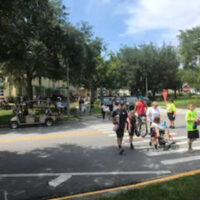Why It’s Important to Review Safety Laws of Pedestrian Travel with Your Kids

Schools across the state of Florida have transitioned to in-person learning, with children returning to the brick-and-mortar buildings they haven’t seen since March of this year. Not only does this mean that kids will once again be walking and biking to bus stops and classes, but due to the pandemic, many children who were previously driven to those locations by their parents will have to transition to pedestrian as their moms and dads are busy working from home. Unfortunately, South Florida, is considered the 14th most dangerous place in the country for auto-pedestrian accidents, according to a study conducted by the nonprofit organization Smart Growth America that analyzed those types of crashes from 2008 to 2017. During those years, data shows that drivers struck and killed 49,340 people who were walking on streets all across the United States. The study found that 5,433 of the deaths occurred in Florida.
Therefore, now more than ever is the time to talk to your kids about pedestrian rules and how to share the roads and sidewalks in the safest way possible. Things to discuss include:
- Any person afoot is a pedestrian, including those in a wheelchair or on roller skates.
- Aside from maintenance or governmental personnel, a person may not walk upon a highway or a highway ramp connecting to any other street or freeway.
- If there is a sidewalk on the street, you have to use it.If there’s no sidewalk, you can walk on the road, but you always have to be facing traffic, not walking in the direction of it. If both driver and pedestrian can see each other, an accident is much less likely to occur.
- Cyclists are not pedestrians, so when on a bike, you should be going in the direction of traffic, preferably in a bike lane if there is one.
- Pedestrians have the right-of-way on a marked crosswalk, however, a pedestrian crossing a road at any other point must yield the right-of-way to all vehicles. (And remember to always look both ways!)
- Pedestrians must obey all traffic signals and cross a road only when the pedestrian light is on.
- Even when a pedestrian has the right-of-way, pedestrians should make eye contact with drivers before crossing a road to ensure they see him/her and be certain they will stop and aren’t distracted by something.
- It is illegal to stand on the road to hail a cab, wave down a friend, save a parking spot or guard your car. Stay to the side of the road.
- A violation of the above-mentioned laws is a noncriminal traffic infraction, punishable as a pedestrian violation, and the amount of the penalty is $15, but like any ticket, you can go to court to fight it as well.
While discussing pedestrian rules, it is important to warn your kids that just because they are following the rules, doesn’t necessarily mean everyone else is. They should always look both ways – but not just once, not even twice. Pedestrians should always be alert of all the activity surrounding them to best anticipate any situation that may arise. Never assume a car is going to give them the right of way, even if it’s lawfully theirs. Never be an aggressor and always be on the defensive while walking or biking. And if possible, the buddy system is never a bad idea.
